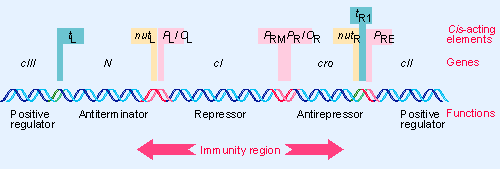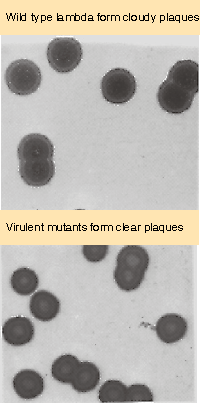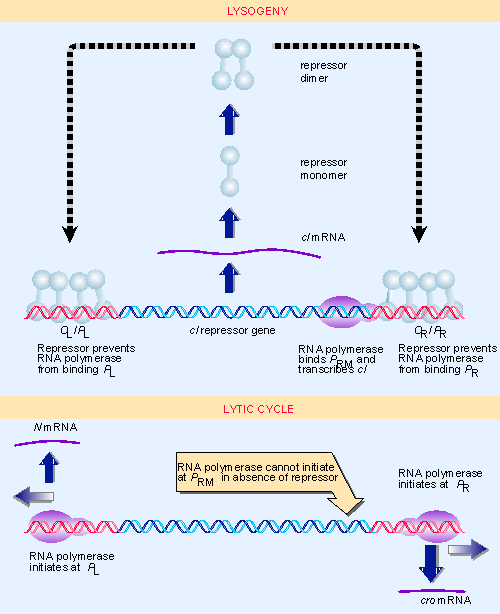5. Lysogeny is maintained by an autogenous circuit
11.5 Lysogeny is maintained by an autogenous circuit |
| Key terms defined in this section |
| Immunity in phages refers to the ability of a prophage to prevent another phage of the same type from infecting a cell. It results from the synthesis of phage repressor by the prophage genome. Virulent phage mutants are unable to establish lysogeny. |
Looking at the lambda lytic cascade, we see that the entire program is set in train by initiating transcription at the two promoters PL and PR for the immediate early genes N and cro. Because lambda uses antitermination to proceed to the next stage of (delayed early) expression, the same two promoters continue to be used right through the early period.
 |
Figure 11.12 The lambda regulatory region contains a cluster of trans-acting functions and cis-acting elements. |
The expanded map of the regulatory region drawn in Figure 11.12 shows that the promoters PL and PR lie on either side of the cI gene. Associated with each promoter is an operator (OL, OR) at which repressor protein binds to prevent RNA polymerase from initiating transcription. The sequence of each operator overlaps with the promoter that it controls; so often these are described as the PL /OL and PR/OR control regions.
Because of the sequential nature of the lytic cascade, the control regions provide a pressure point at which entry to the entire cycle can be controlled. By denying RNA polymerase access to these promoters, a repressor protein prevents the phage genome from entering the lytic cycle. The repressor functions in the same way as repressors of bacterial operons: it binds to specific operators (Ptashne, 1967; Ptashne, 1967; Pirrotta et al., 1970).
The repressor protein is coded by the cI gene. Mutants in this gene cannot maintain lysogeny, but always enter the lytic cycle. The name of the gene reflects the phenotype of the resulting infection. Since the original isolation of the repressor protein (Ptashne, 1967; see 100.1 Isolation of Repressor), its characterization has shown how it both maintains the lysogenic state and provides immunity for a lysogen against superinfection by further phage lambda.
 |
Figure 11.13 Wild-type and virulent lambda mutants can be distinguished by their plaque types. Photograph kindly provided by Dale Kaiser. |
When a bacterial culture is infected with a phage, the cells are lysed to generate regions that can be seen on a culture plate as small areas of clearing called plaques. With wild-type phages, the plaques are turbid or cloudy, because they contain some cells that have established lysogeny instead of being lysed. The effect of a cI mutation is to prevent lysogeny, so that the plaques contain only lysed cells. As a result, such an infection generates only clear plaques, and three genes (cI, cII, cIII) were named for their involvement in this phenotype. Figure 11.13 compares wild-type and mutant plaques.
The cI gene is transcribed from a promoter PRM that lies at its right end. (The subscript "RM" stands for repressor maintenance.) Transcription is terminated at the left end of the gene. The mRNA starts with the AUG initiation codon; because of the absence of the usual ribosome binding site, the mRNA is translated somewhat inefficiently, producing only a low level of repressor protein.
 |
Figure 11.14 Lysogeny is maintained by an autogenous circuit (upper). If this circuit is interrupted, the lytic cycle starts (lower). |
The repressor binds independently to the two operators. It has a single function at OL, but has dual functions at OR. These are illustrated in the upper part of Figure 11.14.
At OL the repressor has the same sort of effect that we have already discussed for several other systems: it prevents RNA polymerase from initiating transcription at PL. This stops the expression of gene N. Since PL is used for all leftward early gene transcription, this action prevents expression of the entire leftward early transcription unit. So the lytic cycle is stymied before it can proceed beyond the early stages.
At OR, repressor binding prevents the use of PR. So cro and the other rightward early genes cannot be expressed. (We see later why it is important to prevent the expression of cro when lysogeny is being maintained.)
But the presence of repressor at OR also has another effect. The promoter for repressor synthesis, PRM, is adjacent to the rightward operator OR. It turns out that RNA polymerase can initiate efficiently at PRM only when repressor is bound at OR. The repressor behaves as a positive regulator protein that is necessary for transcription of the cI gene. Since the repressor is the product of cI, this interaction creates a positive autogenous circuit, in which the presence of repressor is necessary to support its own continued synthesis.
The nature of this control circuit explains the biological features of lysogenic existence. Lysogeny is stable because the control circuit ensures that, so long as the level of repressor is adequate, there is continued expression of the cI gene. The result is that OL and OR remain occupied indefinitely. By repressing the entire lytic cascade, this action maintains the prophage in its inert form.
The presence of repressor explains the phenomenon of immunity. If a second lambda phage DNA enters a lysogenic cell, repressor protein synthesized from the resident prophage genome will immediately bind to OL and OR in the new genome. This prevents the second phage from entering the lytic cycle.
The operators were originally identified as the targets for repressor action by virulent mutations (λvir). These mutations prevent the repressor from binding at OL or OR, with the result that the phage inevitably proceeds into the lytic pathway when it infects a new host bacterium. And λvir mutants can grow on lysogens because the virulent mutations in OL and OR allow the incoming phage to ignore the resident repressor and thus to enter the lytic cycle. Virulent mutations in phages are the equivalent of operator-constitutive mutations in bacterial operons.
Prophage is induced to enter the lytic cycle when the lysogenic circuit is broken. This happens when the repressor is inactivated (see next section). The absence of repressor allows RNA polymerase to bind at PL and PR, starting the lytic cycle as shown in the lower part of Figure 11.14 (for review see Friedman and Gottesman, 1982).
The autogenous nature of the repressor-maintenance circuit creates a sensitive response. Because the presence of repressor is necessary for its own synthesis, expression of the cI gene stops as soon as the existing repressor is destroyed. So no repressor is synthesized to replace the molecules that have been damaged. This enables the lytic cycle to start without interference from the circuit that maintains lysogeny.
The region including the left and right operators, the cI gene, and the cro gene determines the immunity of the phage. Any phage that possesses this region has the same type of immunity, because it specifies both the repressor protein and the sites on which the repressor acts. Accordingly, this is called the immunity region (as marked in Figure 11.12). Each of the four lambdoid phages φ80, 21, 434, and λ has a unique immunity region. When we say that a lysogenic phage confers immunity to any other phage of the same type, we mean more precisely that the immunity is to any other phage that has the same immunity region (irrespective of differences in other regions).
| Reviews | |
| Friedman, D. I. and Gottesman, M. (1982). Lytic mode of lambda development In Lambda. In Lambda II, Eds. R. W. Hendrix, J. W. Roberts, F. W. Stahl and R. A. Weisberg, Cold Spring Harbor 21-51. | |
| Research | |
| Pirrotta, V., Chadwick, P., and Ptashne, M. (1970). Active form of two coliphage repressors. Nature 227, 41-44. | |
| Ptashne, M. (1967). Isolation of the l phage repressor. Proc. Nat. Acad. Sci. USA 57, 306-313. | |
| Ptashne, M. (1967). Specific binding of the l phage repressor to DNA. Nature 214, 232-234. | |